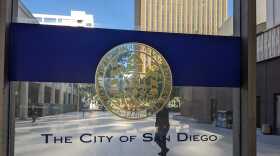Willie Morrow knows a thing or two about hair.
"I don’t make no bones about it," the 76-year-old said. "I know a lot about black hair, straight hair, curly hair, wavy hair, you name it. I’m a hair guy."
For years, Morrow owned a barbershop on Market Street in southeastern San Diego. He also developed an African-American hair care line called "California Curl." Through it, he invented products that changed the African-American beauty industry.
A new exhibit at the Museum at California Center for the Arts, Escondido looks at Morrow’s career and with it, the complicated history and culture around black hair care. It’s called "The History and the Hair Story: 400 Years Without A Comb." The title comes from Morrow’s invention of a comb with wider, flexible teeth.
"Before Dr. Morrow, there were no instruments made in America that worked well on curly hair," said Starla Lewis, San Diego Mesa College professor of black history. Lewis curated the exhibit which features more than 250 objects, from paintings to vintage styling equipment. Most of the objects are part of Morrow’s own private collection.
The exhibit includes a diorama of Morrow’s Market Street barbershop, which served as a central meeting place for San Diego’s black community in the 1960s. It includes the barber chair he used for years, the red velvet on the neck rest worn from use. Basketball great Michael Jordan sat in that chair.


So did black politicians and many of the San Diego Chargers, including offensive guard Ernie Barnes. Barnes went on to become a well-known painter, whose work was most famously used for the opening and closing credits of the 1970s television show "Good Times."

His painting "The Sugar Shack" became the cover of Marvin Gaye’s 14th studio album.
Barnes’ portrait of Morrow’s barber shop hangs on the wall in the museum. It’s a crowded, bustling scene full of stock characters. They're painted in Barnes' signature style of elongating the limbs and curves of his figures. Guys play checkers in the foreground. The painting is Morrow’s most prized piece.
"This guy here has the Bible, then there’s the Muslim guys with the newspapers, and the barber talking to everyone," Morrow said, pointing to each group. "Everybody that was anybody went to the barber shop and we would discuss the issues."

Lewis went to Morrow’s barbershop to have her afro cut to a close-cropped natural in 1975. She said it was always fun to hang out at the barbershop.
"There was always lots of joking around and laughing," Lewis said. "I think some people needed a thick skin because some of the joking got 'your mama.'"
Morrow said he did more than cut hair in the shop.
"Once you’re a barber, you become the godfather of the community. People ask you everything. How to borrow money, how to buy a house, how to buy a car," Morrow said.
In the 1970s, Morrow contracted with the Defense Department and traveled around the world cutting hair on military bases and teaching servicemen how to cut black hair.
Frustrated with the lack of safe products in the beauty industry, he taught himself the chemistry involved in making gentle relaxers and perms to straighten the hair. He started a company called California Curl and created a product that relaxed the hair in gentle curls, a style he says inspired the popular 1980s look known as the Jheri Curl.
"I try to make products that are first of all, chemically solid," Morrow said. "I don’t make product to be making them and burning folk’s hair and scalp."
Morrow wears his own hair straightened and in a long pony tail. He says the fact that he has so much hair is proof that his products work.
Morrow tests new products in a small lab in a crowded warehouse in Lemon Grove. The space, next to an auto body shop, serves as his lab, mail center, office, and storage for his massive collection of historic hair care memorabilia dating back to slavery.
Morrow tests his products on natural hair to see how the hair behaves with each chemical combination. He’s had prisoners donate their hair to his lab, but he also collects hair from members of the community.
Standing in his office surrounded by framed newspaper articles about his work, Morrow grabs an old leather bound Bible. He opens it and holds up some strands of curly black hair.
"That’s not very much, but like that. I use these pieces to practice on," Morrow said.
Why are there strands of hair in the pages of his Bible?
Morrow takes the Bible out into the community when he cuts and collects hair. He says it helps fight superstitions. He said some people "don’t want to cut it off their hair because if the birds get it, 'my grandmamma told me you won’t live long.'"
"There’s just a lot of superstitions that go along with it so if they believe in the Bible, I just cut it and put it in here and they relax,” Morrow said.
Curator Lewis said the history and culture around black hair is complicated. It involves racism, poverty, and identity politics. Sometimes that history is fraught, sometimes joyous. She said Willie Morrow is a key figure in it all
"I believe that Dr. Morrow did what he did and dedicated his life because he loved black people," Lewis said. "He knew that as a people we were struggling to love ourselves in a society where we experience so much rejection."
"The History and the Hair Story: 400 Years Without A Comb" runs through March 6 at the Museum at California Center for the Arts, Escondido, on North Escondido Boulevard. Admission is $8.






